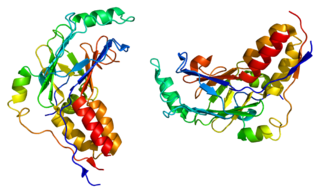
Lymphedema, also known as lymphoedema and lymphatic edema, is a condition of localized swelling caused by a compromised lymphatic system. The lymphatic system functions as a critical portion of the body's immune system and returns interstitial fluid to the bloodstream.
The epithelial–mesenchymal transition (EMT) is a process by which epithelial cells lose their cell polarity and cell–cell adhesion, and gain migratory and invasive properties to become mesenchymal stem cells; these are multipotent stromal cells that can differentiate into a variety of cell types. EMT is essential for numerous developmental processes including mesoderm formation and neural tube formation. EMT has also been shown to occur in wound healing, in organ fibrosis and in the initiation of metastasis in cancer progression.

Mothers against decapentaplegic homolog 3 also known as SMAD family member 3 or SMAD3 is a protein that in humans is encoded by the SMAD3 gene.

Lymphedema–distichiasis syndrome is a medical condition associated with the FOXC2 gene. People with this hereditary condition have a double row of eyelashes, which is called distichiasis, and a risk of swollen limbs due to problems in the lymphatic system.

Mesenchyme is a type of loosely organized animal embryonic connective tissue of undifferentiated cells that give rise to most tissues, such as skin, blood or bone. The interactions between mesenchyme and epithelium help to form nearly every organ in the developing embryo.

Forkhead box O3, also known as FOXO3 or FOXO3a, is a human protein encoded by the FOXO3 gene.

Forkhead box C1, also known as FOXC1, is a protein which in humans is encoded by the FOXC1 gene.

Forkhead box protein L2 is a protein that in humans is encoded by the FOXL2 gene.

Zinc finger protein SNAI2 is a transcription factor that in humans is encoded by the SNAI2 gene. It promotes the differentiation and migration of certain cells and has roles in initiating gastrulation.

Transcription factor SOX-18 is a protein that in humans is encoded by the SOX18 gene.

Forkhead box protein E1 is a protein that in humans is encoded by the FOXE1 gene.

Forkhead box protein F1 (FOXF1) is a protein that in humans is encoded by the FOXF1 gene.

POU domain, class 3, transcription factor 4 is a protein that in humans is encoded by the POU3F4 gene found on the X chromosome.

Homeobox protein goosecoid(GSC) is a homeobox protein that is encoded in humans by the GSC gene. Like other homeobox proteins, goosecoid functions as a transcription factor involved in morphogenesis. In Xenopus, GSC is thought to play a crucial role in the phenomenon of the Spemann-Mangold organizer. Through lineage tracing and timelapse microscopy, the effects of GSC on neighboring cell fates could be observed. In an experiment that injected cells with GSC and observed the effects of uninjected cells, GSC recruited neighboring uninjected cells in the dorsal blastopore lip of the Xenopus gastrula to form a twinned dorsal axis, suggesting that the goosecoid protein plays a role in the regulation and migration of cells during gastrulation.

Leucine-zipper-like transcriptional regulator 1 is a protein that in humans is encoded by the LZTR1 gene.

Milroy's disease (MD) is a familial disease characterized by lymphedema, commonly in the legs, caused by congenital abnormalities in the lymphatic system. Disruption of the normal drainage of lymph leads to fluid accumulation and hypertrophy of soft tissues.
A mesenchymal–epithelial transition (MET) is a reversible biological process that involves the transition from motile, multipolar or spindle-shaped mesenchymal cells to planar arrays of polarized cells called epithelia. MET is the reverse process of epithelial–mesenchymal transition (EMT) and it has been shown to occur in normal development, induced pluripotent stem cell reprogramming, cancer metastasis and wound healing.

Forkhead box protein A1 (FOXA1), also known as hepatocyte nuclear factor 3-alpha (HNF-3A), is a protein that in humans is encoded by the FOXA1 gene.

Forkhead box protein E3 (FOXE3) also known as forkhead-related transcription factor 8 (FREAC-8) is a protein that in humans is encoded by the FOXE3 gene located on the short arm of chromosome 1.

Forkhead box protein J1 is a protein that in humans is encoded by the FOXJ1 gene. It is a member of the Forkhead/winged helix (FOX) family of transcription factors that is involved in ciliogenesis. FOXJ1 is expressed in ciliated cells of the lung, choroid plexus, reproductive tract, embryonic kidney and pre-somite embryo stage.





















